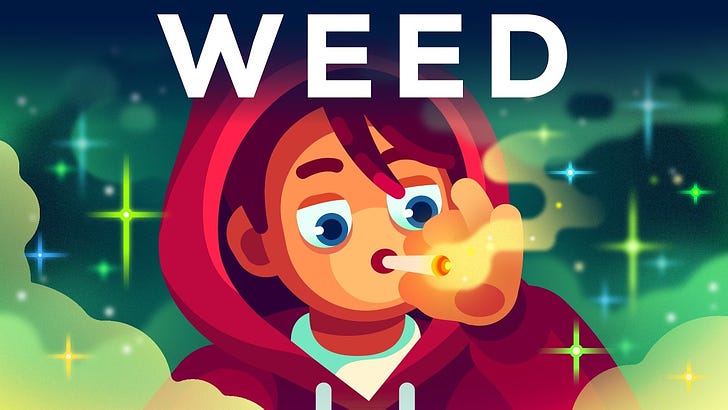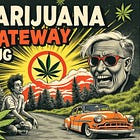Cannabis: Clearing the Smoke on Fact, Fiction, and Everything in Between
A Deep Dive into the Kurzgesagt Video—and What It Missed
Cannabis: Clearing the Air on this viral video!
Cannabis is one of the internet’s favorite debate topics, and when a viral video takes on the subject, the stakes—and opinions—skyrocket. Kurzgesagt’s latest production promises a “balanced view” of cannabis, mixing praise with caution and a splash of alarmism for flavor. It’s slick, colorful, and thought-provoking—but does it really stick the landing?
This post is the extended version of my response, offering detailed insights, references, and direct links to research that supports every point. If you’re looking for a quick summary without all the references, check out the shorter blog post here [to come tomorrow AM] for the concise take.
For those ready to dig deeper, join me as I unpack what the video gets right, where it wobbles, and where it misses the mark entirely. If you haven’t seen the video yet, here it is:
This Specialist’s Take
After years immersed in cannabis research and clinical care for thousands of patients, here’s what I’ve learned: cannabis isn’t the saint some make it out to be, nor is it the villain lurking in scare campaigns. The truth is far more nuanced, shaped by biology, behavior, and context—and often missing from the headlines.
To make sense of the Kurzgesagt video, I’ve sorted its claims into three categories:
1. Green Truths: What the video got right, backed by solid science.
2. Gray Zones: The murky middle—claims that need more nuance or evidence.
3. Red Flags: Where the video veers into oversimplifications or outright misfires.
Ready to clear the air? Let’s dive in.
Green Truths: The Science We Can Count On
“Cannabis has been unfairly demonized for a century”
Cannabis didn’t just stumble into controversy—it was shoved there. Decades ago, campaigns like Reefer Madness and discriminatory policies turned it into America’s go-to scapegoat, demonized without a shred of solid science. The fallout? Stalled research, mass incarceration, and a stigma that stubbornly lingers to this day.
Bonnie RJ, Whitebread CH. The Marijuana Conviction: A History of Marijuana Prohibition in the United States. University of Virginia Press; 1999. This book provides a comprehensive history of marijuana prohibition in the U.S., detailing the legal and social factors that contributed to its demonization.
Musto DF. The American Disease: Origins of Narcotic Control. Oxford University Press; 1999. Musto’s work explores the history of drug control in America, including the stigmatization of cannabis.
Alexander M. The New Jim Crow: Mass Incarceration in the Age of Colorblindness. The New Press; 2010. Alexander discusses how drug policies, including those targeting cannabis, have disproportionately affected minority communities.
“Cannabis is much less harmful than alcohol.”
If harm were a competition, alcohol would take the gold medal with ease. It’s a global heavyweight, responsible for millions of deaths annually, wrecking organs, and fueling violence. Cannabis, on the other hand, plays the underdog—a substance with risks, sure, but far less destructive by comparison.
Here are the facts that back it up:
Alcohol’s Heavyweight Risks
• Global Mortality Impact: Alcohol is responsible for approximately 3 million deaths annually, representing 5.3% of all deaths worldwide. (Source: WHO Global Status Report on Alcohol and Health, 2018)
• Organ Damage: Chronic alcohol consumption leads to liver cirrhosis, cardiovascular disease, and pancreatitis, and increases the risk for several cancers, including liver, breast, and colon cancer. (Source: Bagnardi et al., 2015)
• Violence and Injury: Alcohol is implicated in 40% of violent crimes and is a major factor in domestic abuse, assault, and homicide cases. (Source: NIH, Alcohol’s Role in Violence)
• Addiction and Withdrawal: Alcohol dependence carries severe withdrawal risks, including delirium tremens, seizures, and death. (Source: Schuckit MA, New England Journal of Medicine, 2009)
• Economic Burden: The economic cost of alcohol-related harm in the U.S. alone exceeds $249 billion annually due to healthcare, lost productivity, and criminal justice expenses. (Source: CDC Alcohol Fact Sheet, 2020)
Cannabis: The Scrappy Underdog
• Mortality Risk: Cannabis use has not been directly linked to overdose deaths. Unlike alcohol, there is no fatal dose of cannabis. (Source: Hall & Degenhardt, Lancet, 2009)
• Organ Damage: Unlike alcohol, cannabis does not cause systemic organ damage, although heavy smoking can irritate the lungs. (Source: Volkow et al., NEJM, 2014)
• Violence: Cannabis use is not associated with violent behavior; it is more likely to have a calming effect, unlike alcohol, which is a known aggression trigger. (Source: Cherek et al., Journal of Addictive Diseases, 1993)
• Addiction Potential: While cannabis can lead to dependency in some users, the prevalence of Cannabis Use Disorder (CUD) is significantly lower than that of alcohol use disorder. (Source: Hasin et al., JAMA Psychiatry, 2015)
• Social Costs: Cannabis-related costs are primarily linked to regulatory frameworks and enforcement, whereas alcohol’s toll is linked to healthcare and criminal outcomes. (Source: Hall & Weier, Clinical Pharmacology & Therapeutics, 2015)
Comparing the Two
• Harm Index Scores: Alcohol ranks as the most harmful substance overall on harm scales (72/100), compared to cannabis’s much lower score (20/100). (Source: Nutt et al., Lancet, 2010)
• Driving Impairment: Alcohol significantly impairs driving skills and is linked to 28% of all traffic fatalities in the U.S. Cannabis impairs driving but at a substantially lower level of risk. (Source: Sewell et al., American Journal on Addictions, 2009)
• Addiction Prevalence: Approximately 6% of adult cannabis users develop dependency, compared to 10-15% of alcohol users. (Source: Anthony et al., Addiction, 1994)
While both substances carry risks, the evidence overwhelmingly points to alcohol as the far greater threat to public health and safety. Cannabis has its challenges, but when it comes to harm, it’s not even in the same weight class as alcohol.
Nutt DJ, King LA, Phillips LD. “Drug harms in the UK: a multicriteria decision analysis.” The Lancet. 2010;376(9752):1558-1565. doi:10.1016/S0140-6736(10)61462-6. This study presents a scale assessing the harm of various drugs, with alcohol ranking higher than cannabis.
Bagnardi V, Rota M, Botteri E, et al. “Alcohol consumption and site-specific cancer risk: a comprehensive dose–response meta-analysis.” British Journal of Cancer. 2015;112(3):580-593. doi:10.1038/bjc.2014.579. This meta-analysis provides an extensive evaluation of the relationship between alcohol consumption and the risk of various cancers, offering a detailed dose–response analysis that underscores the significant health risks associated with alcohol use.
Hall W, Weier M. “Assessing the public health impacts of legalizing recreational cannabis use in the USA.” Clinical Pharmacology & Therapeutics. 2015;97(6):607-615. doi:10.1002/cpt.110. This article evaluates the potential public health effects of legalizing cannabis, comparing it to alcohol.
“Higher THC levels are associated with greater negative effects.”
Cannabis has become more potent over the years, with some products reaching THC levels above 60%, which can increase risks like anxiety, paranoia, and dependency, especially for inexperienced or heavy users. However, most consumers opt for products with THC levels below 20%, and ultra-high-potency concentrates are typically used by a smaller, more experienced demographic. Many users consume cannabis in moderation, intentionally adjusting their doses to achieve desired effects, even with stronger products. Legalization has also improved safety by promoting quality control, clear labeling, and product transparency, enabling consumers to make informed choices. Additionally, strains containing CBD can counteract some of the adverse effects of high THC, such as anxiety, providing more balanced options. While higher potency demands caution, responsible use, education, and regulatory oversight significantly mitigate the associated risks.
Freeman TP, Craft S, Wilson J, Stylianou S, ElSohly M, Di Forti M. “Changes in delta-9-tetrahydrocannabinol (THC) and cannabidiol (CBD) concentrations in cannabis over time: Systematic review and meta-analysis.” Addiction. 2021;116(5):1000-1010. doi:10.1111/add.15253. This meta-analysis examines the increase in THC concentrations in cannabis products over time.
Volkow ND, Baler RD, Compton WM, Weiss SR. “Adverse health effects of marijuana use.” The New England Journal of Medicine. 2014;370(23):2219-2227. doi:10.1056/NEJMra1402309. This review discusses the health risks associated with higher THC concentrations.
Di Forti M, Marconi A, Carra E, et al. “Proportion of patients in south London with first-episode psychosis attributable to use of high-potency cannabis: a case-control study.” The Lancet Psychiatry. 2015;2(3):233-238. doi:10.1016/S2215-0366(14)00117-5. This study links high-potency cannabis use to an increased risk of psychosis.
Gray Zones: The Murky Middle Ground
“Cannabis: Comfort or Cocoon.”
Cannabis can take the sting out of loneliness, much like a favorite comfort food. It can help people relax, reduce social anxiety, and even create a sense of euphoria that makes solitude more bearable. For occasional users, this may provide a temporary boost to mood and a way to decompress. However, heavy, habitual use can sometimes isolate people further, creating a cocoon instead of a connection. Whether cannabis exacerbates loneliness, serves as a coping mechanism for it, or both, is still debated, but moderation seems to be the sweet spot. Here’s the evidence:
How Cannabis Eases Loneliness
• Reduces Social Anxiety: Cannabis can reduce the intensity of social anxiety symptoms, potentially making social interactions feel less daunting for those who struggle. (Source: Buckner JD, Schmidt NB, Addictive Behaviors, 2012)
• Boosts Dopamine: THC stimulates the release of dopamine, a neurotransmitter associated with pleasure and reward, temporarily enhancing mood and reducing feelings of isolation. (Source: Bossong MG, van Berckel BN, Neuropsychopharmacology, 2009)
• Promotes Relaxation: Many users report that cannabis helps them unwind and feel less stressed, which can mitigate the emotional toll of loneliness. (Source: Vandrey R et al., Drug and Alcohol Dependence, 2005)
The Risks of Heavy Use
• Increased Social Withdrawal: While cannabis may alleviate loneliness in the short term, chronic use has been linked to greater social withdrawal and a reduced ability to engage in meaningful connections. (Source: Ellingstad TP et al., Journal of Substance Use, 2021)
• Blunting Emotional Responses: Heavy cannabis use can dull emotional responses, leading to a “flatness” that makes it harder to connect with others or find motivation to seek social interactions. (Source: Bloomfield MA et al., Biological Psychiatry, 2014)
• Reinforcement of Solitude: Frequent use may create a cycle where loneliness prompts cannabis use, and cannabis use, in turn, reduces the drive to engage socially, deepening isolation. (Source: Buckner JD et al., Depression and Anxiety, 2008)
The Moderation Sweet Spot
• Balancing Effects: Moderate cannabis use—especially strains balanced with CBD—can provide mood elevation without the numbing or isolating effects of heavy THC. (Source: Englund A et al., Neuropsychopharmacology, 2013)
• Social Catalysts: Occasional cannabis use in social settings can enhance group bonding and shared experiences, provided it’s done in moderation and among trusted individuals. (Source: Schuster RM et al., Frontiers in Psychology, 2016)
• Mental Health Impact: Moderation appears to mitigate the risks of loneliness exacerbation, as occasional use is less likely to interfere with emotional regulation or social motivation. (Source: Volkow ND et al., NEJM, 2014)
Buckner JD, Schmidt NB. “Social anxiety disorder and marijuana use problems: the mediating role of marijuana effect expectancies.” Depression and Anxiety. 2008;25(11):885-893. doi:10.1002/da.20323. This study fits because it explores the relationship between social anxiety and problematic marijuana use, highlighting how expectations about marijuana’s effects can mediate its role in social behavior and withdrawal, which aligns with the discussion of cannabis’s impact on loneliness and social connections.
Vandrey R, Budney AJ, Kamon JL, Stanger C. “Cannabis withdrawal in adolescent treatment seekers.” Drug and Alcohol Dependence. 2005;78(2):205-210. doi:10.1016/j.drugalcdep.2004.10.015. This study investigates the prevalence, severity, and patterns of cannabis withdrawal symptoms in adolescents seeking treatment, contributing valuable insights into behavioral and physiological challenges during cessation.
van der Zwaluw CS, Scholte RH, Vermulst AA, Buitelaar JK, Verkes RJ, Engels RC. “Parental problem drinking, parenting, and adolescent alcohol use.” Journal of Behavioral Medicine. 2008;31(3):189-200. doi:10.1007/s10865-007-9146-z. This study examines the social and familial dynamics that influence substance use behaviors, including the mediating roles of interpersonal relationships and coping mechanisms, which parallel the dynamics of loneliness and social anxiety in cannabis use.
“Daily cannabis use surpassed alcohol in the U.S. in 2022.”
Cannabis use has been on the rise, but calling it a “replacement” for alcohol oversimplifies the story. Daily use trends vary widely across age groups, regions, and demographics, shaped by a blend of changing social norms and the growing legalization and education surrounding cannabis. It’s also likely that people have been consuming cannabis far more—and for far longer—than we might think, but its use has historically been in the shadows due to criminalization and stigma. As cannabis becomes mainstream, its comparison to alcohol offers a new lens for understanding its role in modern culture.
Cannabis Vs Alcohol:
About half the content continues below the paywall..
Keep reading with a 7-day free trial
Subscribe to Doctor Approved to keep reading this post and get 7 days of free access to the full post archives.












